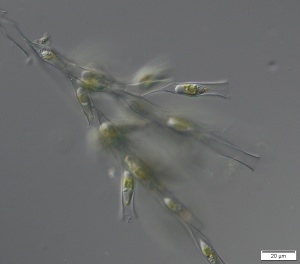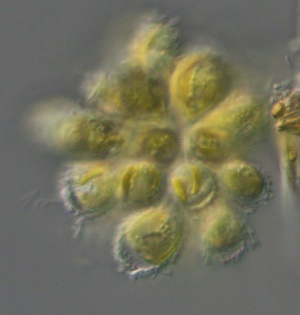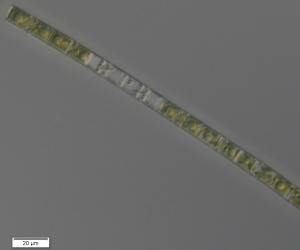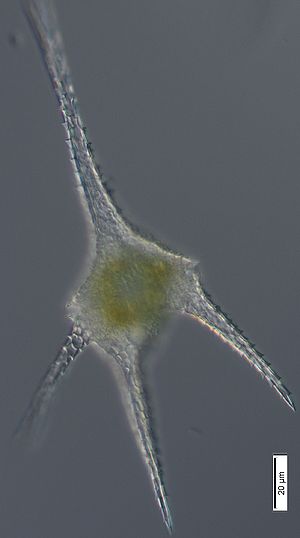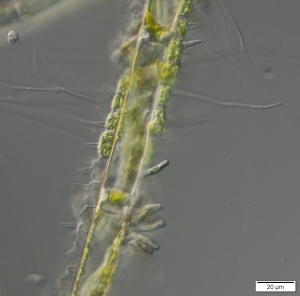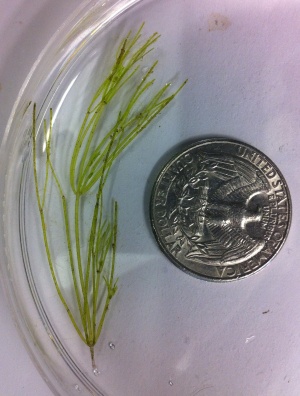Difference between revisions of "Algae around UConn"
m |
|||
| Line 5: | Line 5: | ||
==[http://tolweb.org/Stramenopiles/2380 Stramenopiles]== | ==[http://tolweb.org/Stramenopiles/2380 Stramenopiles]== | ||
Many microscopic and macroscopic algae belong to the group called Stramenopiles (also referred to as heterokonts). Diatoms, Chrysophytes, and Synurophytes are microscopic, and Phaeophytes (kelps, or brown algae) are mostly macroscopic and marine. | Many microscopic and macroscopic algae belong to the group called Stramenopiles (also referred to as heterokonts). Diatoms, Chrysophytes, and Synurophytes are microscopic, and Phaeophytes (kelps, or brown algae) are mostly macroscopic and marine. | ||
| − | ''Dinobryon'' is a colonial flagellated alga from the class Chrysophyceae. Another colonial chrysophyte is [http://youtu.be/xDhYQMy1xXo ''Uroglenopsis''], also found in CT (Middle Bolton Lake). | + | *''Dinobryon'' is a colonial flagellated alga from the class Chrysophyceae. Another colonial chrysophyte is [http://youtu.be/xDhYQMy1xXo ''Uroglenopsis''], also found in CT (Middle Bolton Lake). |
[[Image:Dinobryon.jpg|thumb|left|''Dinobryon'' cf. ''cylindricum'' from Walker Reservoir, Vernon, CT]] | [[Image:Dinobryon.jpg|thumb|left|''Dinobryon'' cf. ''cylindricum'' from Walker Reservoir, Vernon, CT]] | ||
*''Synura'' is a genus of the Synurophyceae, a sister group to Chrysophyceae. Their plastids give members of both groups a typical golden-brown color. Synurophyceae have cells covered with siliceous scales. Detailed examination of scale morphology is often needed for species identification. Colonies of ''Synura'' are not the most elegant of swimmers, but are fun to [https://www.youtube.com/watch?v=yYgIEOfo8J0&feature=youtu.be watch] tumbling around. | *''Synura'' is a genus of the Synurophyceae, a sister group to Chrysophyceae. Their plastids give members of both groups a typical golden-brown color. Synurophyceae have cells covered with siliceous scales. Detailed examination of scale morphology is often needed for species identification. Colonies of ''Synura'' are not the most elegant of swimmers, but are fun to [https://www.youtube.com/watch?v=yYgIEOfo8J0&feature=youtu.be watch] tumbling around. | ||
| Line 11: | Line 11: | ||
[[Image:Uroglenopsis.jpg|thumb|center|''Uroglenopsis'' cf. ''americana'' from Middle Bolton Lake, Vernon, CT]] | [[Image:Uroglenopsis.jpg|thumb|center|''Uroglenopsis'' cf. ''americana'' from Middle Bolton Lake, Vernon, CT]] | ||
[[Image:Melosira.jpg|thumb|left|''Melosira'' sp., a common chain-forming diatom from Middle Bolton Lake, Vernon, CT]] | [[Image:Melosira.jpg|thumb|left|''Melosira'' sp., a common chain-forming diatom from Middle Bolton Lake, Vernon, CT]] | ||
| − | [[Image:Tabellaria.jpg|thumb| | + | [[Image:Tabellaria.jpg|thumb|right|''Tabellaria'' sp., a common colony-forming diatom from Middle Bolton Lake, Vernon, CT]] |
| − | + | <br><br><br><br><br><br><br><br><br><br><br> | |
==Dinoflagellates== | ==Dinoflagellates== | ||
| − | Dinoflagellates are a group related to the Stramenopiles | + | Dinoflagellates are a group related to the Stramenopiles. ''Ceratium'' and ''Peridinium'' are common freshwater genera. |
[[Image:Ceratium.jpg|thumb|left|''Ceratium'' sp. from Middle Bolton Lake, Vernon, CT]] | [[Image:Ceratium.jpg|thumb|left|''Ceratium'' sp. from Middle Bolton Lake, Vernon, CT]] | ||
| − | + | <br><br><br> | |
| + | <br><br><br><br> | ||
==Green algae== | ==Green algae== | ||
*Some algae grow on plants or on other algae - epiphytically. ''Aphanochaete'' from the order Chaetophorales, is an example of a green filamentous alga growing on another green filamentous alga, ''Oedogonium'' (order Oedogoniales). | *Some algae grow on plants or on other algae - epiphytically. ''Aphanochaete'' from the order Chaetophorales, is an example of a green filamentous alga growing on another green filamentous alga, ''Oedogonium'' (order Oedogoniales). | ||
Revision as of 18:23, 20 June 2014
Microorganisms are incredibly diverse. A small sample of water from a local pond can contain dozens of species - some related to plants, some related to fungi, and some belonging to completely different, ancient lineages of eukaryotes. Algae are a subset of this diversity: they are organisms that contain a photosynthetic organelle (plastid). Here are a few examples of the charismatic algae found in the vicinity of the University of Connecticut.
See the map of sampled localities
Stramenopiles
Many microscopic and macroscopic algae belong to the group called Stramenopiles (also referred to as heterokonts). Diatoms, Chrysophytes, and Synurophytes are microscopic, and Phaeophytes (kelps, or brown algae) are mostly macroscopic and marine.
- Dinobryon is a colonial flagellated alga from the class Chrysophyceae. Another colonial chrysophyte is Uroglenopsis, also found in CT (Middle Bolton Lake).
- Synura is a genus of the Synurophyceae, a sister group to Chrysophyceae. Their plastids give members of both groups a typical golden-brown color. Synurophyceae have cells covered with siliceous scales. Detailed examination of scale morphology is often needed for species identification. Colonies of Synura are not the most elegant of swimmers, but are fun to watch tumbling around.
Dinoflagellates
Dinoflagellates are a group related to the Stramenopiles. Ceratium and Peridinium are common freshwater genera.
Green algae
- Some algae grow on plants or on other algae - epiphytically. Aphanochaete from the order Chaetophorales, is an example of a green filamentous alga growing on another green filamentous alga, Oedogonium (order Oedogoniales).
- Not all algae are microscopic. Aside from the conspicuous marine seaweeds, several freshwater algae are also observable by the naked eye. The green algae of the class Charophyceae (stoneworts) can be found in many water bodies in the Northeast, but can be easily mistaken for aquatic plants.
